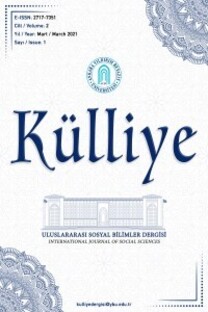İki Dünya Bir Aile 'Sosyolojik Bir Değerlendirme'
Göç olgusu insanlık tarihiyle eş bir olgudur. Dolayısıyla göç olgusuna bağlı olarak bireylerin göç öncesi ve sonrası kültürel kodlarına ilişkin değişimler de sosyolojik anlamda önem arz etmektedir. Bu çerçevede ele alınmış olan İki Dünya Bir Aile eseri Amerika Birleşik Devletleri’ne göç eden Türklerin, farklı bir kültür içerisinde yetişmiş yabancılarla evliliklerinin doğurmuş olduğu sosyolojik sonuçları din kurumu bağlamında ele almaktadır. Bu durum eserde ‘karma evlilik’ üst başlığı altında değerlendirilmiştir. Bu vesileyle yapılan değerlendirmelerde din kurumunun aile kurumunun inşasında önemli bir yeri olduğu tespit edilmiştir. Sosyolojik bir birlik olan ailenin sosyalleşme sürecinde ve toplumsal kurumlar bağlamında bireylerin ilişkilerinde yine önem arz ettiği de belirlenmiştir. Eser göç sosyolojisi ve din sosyolojisi disiplinleri bağlamında kültürel kodların dini kurumlar bağlamında göç sonrası nasıl değişim ve dönüşüm gösterdiğini anlama çabasıdır. Bu çerçevede karma evlilik yapan Türklerin başta kültürel, dini ve kişisel farklılıklardan ötürü sorun-lar yaşadığı görülmüştür. Bu bağlamda değerlendirilen sonuçlar incelendiğinde eserin, derinlemesine mülakatlar ve nicel verileri temel alarak oluşturulduğu gözlenmiştir.
Two Worlds One Family 'A Sociological Assessment'
The phenomenon of migration is a phenomenon equal to human history. Therefore, changes in the pre-migration and post-migration cultural codes of individuals, depending on the phenomenon of migration, are also of importance in sociological terms. The work "Two Worlds One Family", which has been handled within this framework, deals with the sociological consequences of the marriage of Turks immigrating to the United States with foreigners who have grown up in a different culture, in the context of religious institutions. This situation has been evaluated under the title of "mixed marriage" in the work. In the evaluations made on this occasion, it has been determined that the religious institution has an important place in the construction of the family institution. It has also been determined that the family, which is a sociological union, is also important in the socialization process and in the relationships of individuals within the context of social institutions. In the context of the sociology of migration and sociology of religion disciplines, the work is an effort to understand how cultural codes change and transform after migration within the context of religious institutions. In this context, it has been observed that Turks who have mixed marriages experience problems mainly due to cultural, religious and personal differences. When the results evaluated in this context were examined, it was observed that the work was created based on in-depth interviews and quantitative data.
___
- Lee, Everett, S. (1966); A Theory of Migration, Demography. Vol. 3, No. 1. (1966). pp. 47-57. file:///C:/Users/PC/Downloads/Definitionofmigration.pdf (İnternet Erişim Tarihi:18.12.18).
- Marshall, G. (1999). Sosyoloji Sözlüğü. Çev. Osman Akınhay ve D. Kömürcü. Ankara: Bilim Sanat Vakfı Yayınları.
- Petersen, William (1958). A General Typology of Migration. American Sociological Review. Published by: American Sociological Association, Vol. 23. No. 3 (Jun., 1958). pp. 256-266 (11 pages).
- Ravenstein, E. G.(1885). The Laws of Migration. Journal of the Statistical Society of London. Vol. 48. No.2. (Tun., 1885). pp. 167-235, Blackwell Publishing for the Royal Statistical Society.
- Sherkat, Darren E. (2013). Dini Sosyalleşme: Etki Kaynakları ve Araçların Etkileri. çev. Özcan Güngör. International Periodical For The Languages. Literature and History of Turkish or Turkic Volume 8/3. Winter 2013. p. 279-297. ANKARA.
- Yaralıoğlu, Y., Güngör, Ö. (2020). Suriyeli Sığınmacılarda Yapısal Uyum. Dini Sosyalleşme Bağlamında Sosyolojik Bir Değerlendirme: Kilis Örneği. Dini Araştırmalar. 23 (57): 143-172.
- Yıldırım O. (2015). Amerika’da Dinin Siyaset Üzerindeki Etkisi. Ekonomi. İşletme Siyaset ve Uluslararası İlişkiler Dergisi. 1 (2) , 91-108 .
